Voici les différents panneaux du circuit patrimonial Mélusine :
Eglise Saint-Pierre
The Saint-Pierre Church
Do you know who designed the stained glass windows in the church of Vendeuvre?

History
Wars destroyed the original church in the 15th century, leading to the construction of the present-day Saint-Pierre Church, erected between 1502 and 1616.
In 1940, the devastation of the war led to a 20-year-long restoration process. As we currently see it, the building stands as it was when it reopened for worship in 1963, on the site of the old cemetery.
A noteworthy funerary plaque, embedded in the outer wall of the apse at the choir level, commemorates the burial of a former parish priest.
A 19th-century chapel is home to the graves of the lords of the Château de Vendeuvre. The porch belfry provides a link to the Renaissance period. On the left, one can admire a magnificent Pietà, a remarkable specimen of Champagne statuary from the late 15th century.
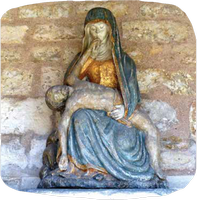
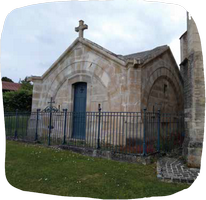
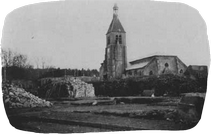
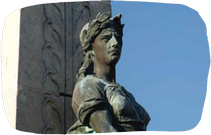
The war memorial
After the First World War, the ‘Sainterie’ also produced commemorative plaques adorning numerous churches. In the early 1920s, France began building countless war memorials all over the country. In 1921, a competition was organised in Vendeuvre to build the town’s memorial. The design submitted by architects HUGOT and ROGER from Troyes was commissioned.
Florentin MEFFROY started his career as a sculptor at the ‘Sainterie’. He created the plaster model of the statue ornamenting the monument and won first prize. His portrayal of ‘La France au Rhin’ (‘France at the Rhine’) was cast in bronze by the GODARD foundry in Paris.
This monument inaugurated on 24 September 1922 in the town hall square was transferred to the site of the old cemetery in 1990.
It honours the memory of 74 soldiers from Vendeuvre who died for France.
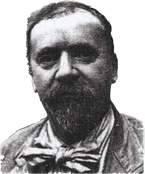
(1854–1927)
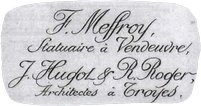
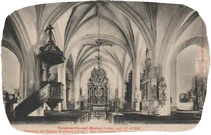
Curiosities
The church features some very fine artwork, including 16th-century paintings and sculptures, including a remarkable high-relief depicting Saint-Hubert, restored for the ‘Le Beau XVIème’ (‘The beautiful 16th century’) exhibition held in Troyes in 2009. It also features a pulpit from the Abbey of Clairvaux, as well as a stunning 1649 altar credited to François GIRARDON.
The resolutely modern touch was brought by Max INGRAND with his magnificent stained glass windows. A dozen statues from the Manufacture d’art chrétien (Christian Art Factory), known as the ‘Sainterie’ of Vendeuvre, embellish the church, some were donated by the NICOT family who took over the firm in 1890 and ran it until 1962.

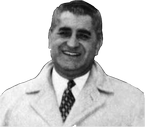
(1908–1969)
Max INGRAND
A student of Jacques GRUBER, he was soon acknowledged as a talented Master glazier and decorator. After designing stained glass windows for the Cathedrals of Rouen, Strasbourg, Tours, Beauvais, and Sao Paulo, he turned his attention to the Saint-Pierre Church. Today, one may admire a unique set comprising some ten windowpanes, including an oculus reminiscent of the local legend of Valsuzenay.
Voici les différents panneaux du circuit patrimonial Mélusine :
Sainterie
The Sainterie
Did you know that Vendreuve was home to ‘Paradise’?
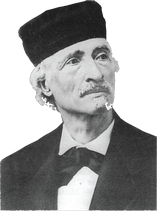
Léon MOYNET
(1818-1892)
The Christian Art Manufactory of Vendeuvre-sur-Barse, known as ‘la Sainterie’, was established by the renowned sculptor Léon MOYNET.
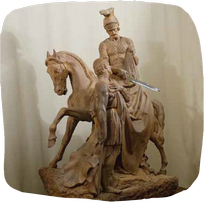
The early days of the Sainterie
Initially established in 1842 in Magny-Fouchard (Aube region), he developed religious terracotta statuary centred around the manufacture of two altars for the parish. His technique, using moulds, meant that, in contrast to traditional wood or stone sculpture, he was able to produce multiple and therefore cheaper editions at a time when the demand for statues was very high.
In 1844, he started producing statues assisted by a handful of workers in a workshop located on the western outskirts of Vendeuvre-sur-Barse. Some structures can still be seen in the vicinity of 77 Avenue de la Libération.
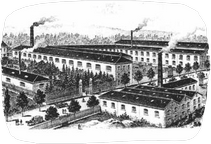
MOYNET, a statuary artist
From 1860, he developed a full-scale industrial complex including a large round kiln and a steam engine to knead the clay.
He reproduced his designs in series and commercialised them through catalogues that were to include photographs from 1869 onwards. He produced several thousand statues each year, appointed 80 employees, and enlisted the help of sculptors to manufacture his designs.
In 1878, the Paris Universal Exhibition allocated him a booth he deemed too small. Consequently, he designed a big exhibition shop for his statues aptly named ‘le Paradis’ (Paradise) which became an attraction for customers and visitors alike.
A few renowned sculptors worked alongside him anonymously: Paul AUBÉ, Eugène MARSON, Ernest TOUSSAINT, and Florentin MEFFROY.
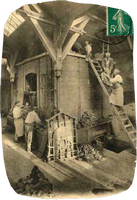
An oven
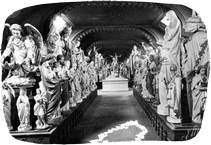
Paradise
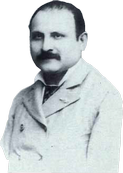
Honoré NICOT
Industrial expansion and decline
In 1890, at the age of 72, MOYNET retired and handed the company over to his accountant Honoré NICOT.
The ‘Sainterie’ continued to develop, particularly internationally, thanks to orders placed by missions. The premises grew with the addition of a new oven, unfortunately, fate struck the NICOTs. Honoré died in 1905, aged 49, and his son Henri was killed during the First World War. The 1905 law on the separation of Church and State and the decline of the worship of Saints marked the beginning of the end for the company. René NICOT diversified his production by making secular statues to no avail. He also tried to produce architectural terracotta pieces in vain. The production of statues came to a halt in 1961.
The memory of this industry is perpetuated by a local association, ‘Artho’, pending the opening of a ‘Sainterie and saintiers’ Museum.
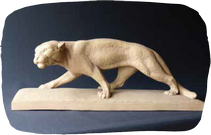
Voici les différents panneaux du circuit patrimonial Mélusine :
Hôtel de Ville
The town hall
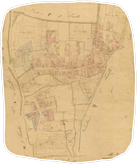
The Communal house
Following the foundation of the communes in December 1789, communal houses were established so elected representatives would meet in a specifically intended location.
The first communal house was located opposite the Barse source, in front of the Moulin CORNET (Mill), at the intersection of the Grande Rue, the Rue du Chapon, and the present day Rue Aimé BRENOT.
From 1790 onwards, ‘arbres de la liberté’ (freedom trees) started to flourish all over the country following the French Revolution.
Since there was insufficient ground for one around the communal house, the Baron of Vendeuvre suggested planting it as close as possible, on a plot of land in the park of the château.
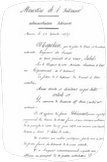
The town hall
In 1853, the first communal house was sold, which helped to finance the purchase of a building that would become the new town hall on the Place du Calvaire, its current location.
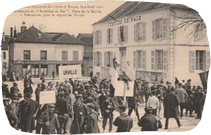
The iron battalion
The exclusion of the Aube region from the delineation of the Champagne appellation vineyards triggered the wrath of the Aube winegrowers. Gaston CHEQ organised a protest march in Bar-sur-Aube. The so-called iron battalion headed for the Prefecture, pausing in front of the Vendeuvre Town Hall on 8 April 1911, and proceeding on to Troyes the following day.
It was only in 1927 that the vineyards of the Aube region, particularly the Côte des Bar, were to join the Champagne appellation.
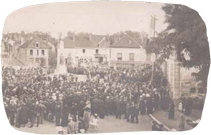
The war memorial
The war memorial replaced the freedom tree and was unveiled on 24 September 1922.
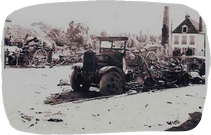
13 and 14 July 1940
Bombing of Vendeuvre.
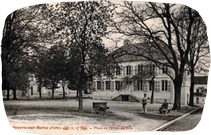
The square
The square took on its existing appearance in the late 1940s when the construction of the bandstand made it a place for gatherings and festivities.
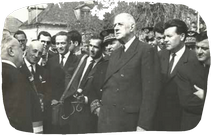
General DE GAULLE
General DE GAULLE, the President of the French Republic, visited Vendeuvre during an official visit of the Aube en Champagne Department in 1963.
Voici les différents panneaux du circuit patrimonial Mélusine en français tels qu'ils sont sur site puis traduits en anglais :
Cliquez sur chaque numéro pour consulter les panneaux
Départ
The Melusine Trail

I am the fairy Melusine, follow me as I unveil the treasures of Vendeuvre-sur-Barse.
2.5 km route
Estimated time approx. 1.5 hours
- Departure – Media Library
- The Town Hall
- The Sainterie
- Saint-Pierre Church
- Water, Treasure and Origins
- The Château
- The Place de la Halle
- Vendeuvre Renowned Figures
- The Engineering Industry
- The Saint-Georges Priory
Four key resources contributed to the growth of Vendeuvre. Their symbolic colours are reflected in the logo of the commune
Water: particularly abundant in the commune, it supplied the mills and industries
Wood: industries and locals alike sourced their wood in the forêt d’Orient massif
Earth: tile and pottery factories gathered clay from local burrows
Iron: forges used the minerals extracted in the open-air site of ‘les Minières’.





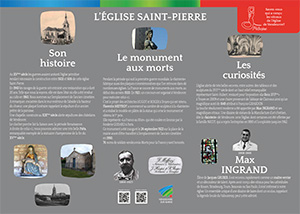
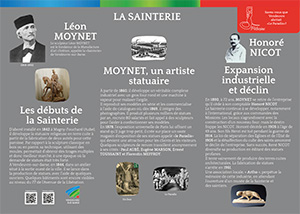
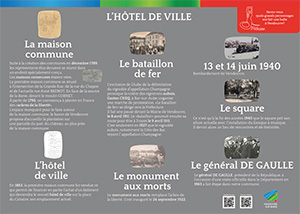
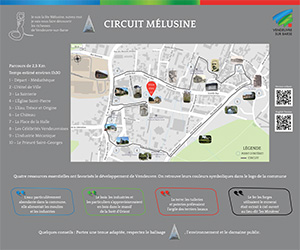
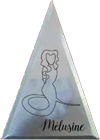 , the environment, and the public domain.
, the environment, and the public domain.